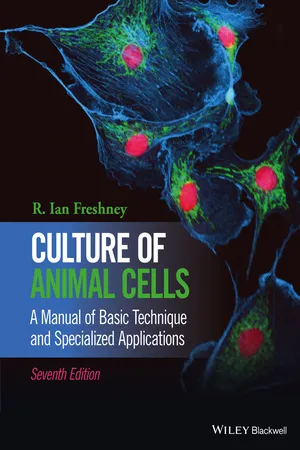Tissue culture, in its various different guises, has been around now for more than a century. As the technique evolves, it is possible to discern three distinct phases: (a) the first period, of approximately 40 years, which was dependent mostly on explantation and studying the behavior of the outgrowth from explants as pioneered by Harrison, Carrel, and others [Harrison 1907; Carrel 1912]; (b) the second period, of approximately 50−60 years, which was dependent of the development of cell lines, both finite, such as WI-38 [Hayflick & Moorhead 1961] and MRC-5 [Jacobs 1970], and continuous, such as the L cell [Earle et al. 1943], HeLa [Gey et al. 1952] and many others; and (c) the third, current period, exploring the analysis and manipulation of gene expression of cell lines and freshly isolated cells. The field has moved from being exploratory research into how to grow cells in vitro, conducted by a few individuals, to a major tool in cell and molecular biology, virology, cellular pathology, bioengineering, and industrial pharmaceutics on a scale never envisioned by the early workers.
With a dramatic increase in the understanding of the role of transcription factors on gene expression, genetic manipulation of commonly and easily cultured cells, such as skin fibroblasts, can convert them into pluripotent stem (iPS) cells, capable of differentiating into a range of different cell types [Lewitzky & Yamanaka 2007; Nakagawa et al. 2007; Yu et al. 2007]. Coupled with the isolation of stem cells from many different tissues in addition to the embryo and the use of chemical inducers of transcriptional changes in the genome (such as valproic acid) the possibility of creating iPS cells by epigenetic manipulation, rather than genetic intervention, becomes a real possibility. The whole concept of irreversible commitment to a particular path of differentiation has had to be revisited as it has proved to be possible to induce transdifferentiation from one lineage to another via reversion to a precursor cell [Kondo & Raff 2000; le Douarin et al. 2004] and even to persuade cells to change lineage without reversion to a more primitive cell [Vierbuchen et al. 2010] first proposed in eye regeneration many years ago [Pritchard et al. 1978; Okada 1983]. The implications of these developments are far-reaching; instead of the need for complex selective culture techniques, simple culture procedures may be used to initiate a cell line and epigenetic manipulation used to convert it into a new phenotype, directly or via regression to a stem cell or other progenitor cell. The possibilities that this opens up for the study of the regulation of differentiation, the determination of errors that occur in abnormal differentiation [Ebert et al. 2009] and malignancy, the provision of screening systems for diagnosis and drug development with cell lines from known pathologies, and the creation of autografts by tissue engineering, promises a further expansion of tissue culture technology and usage comparable to the biotechnology boom of the turn of the last century.
While the development of cell lines has been pivotal to most of the advances in cell culture over the past 50 years, it has brought with it a number of unforeseen problems. The observation that differentiated properties were lost in culture alerted early workers in the field to the problems of dedifferentiation and selection and the fact that cultured cells may be genetically, as well as phenotypically, unstable. What was not predicted was that the generation of cell lines would (1) provide an ideal substrate for the growth of mycoplasma and (2) extend the risks of cross-contamination and misidentification already familiar to microbiologists. It does not count to the credit of present-day cell culturists that both of these problems are often overlooked despite having been recognized in the 1960s. Hence many of the subsequent pages will reinforce the need for good cell culture practice [Balls et al. 2006; Geraghty et al. 2014] and emphasize the need for stringent quality control to minimize the risks of microbial contamination, misidentification, and cross-contamination.
